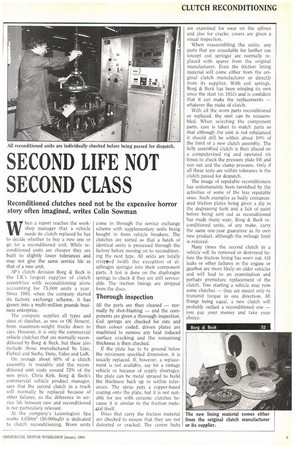SECOND LIFE NOT SECOND CLASS
Page 77

If you've noticed an error in this article please click here to report it so we can fix it.
Reconditioned clutches need not be the expensive horror story often imagined, writes Colin Sowman
When a report reaches the workshop manager that a vehicle needs its clutch replaced he has to decide whether to buy a new one or go for a reconditioned unit. While reconditioned units are cheaper they are built to slightly lower tolerances and may not give the same service life as that of a new unit.
AP's clutch devision Borg & Beck is the UK's largest supplier of clutch assemblies with reconditioning alone accounting for 75,000 units a year. Since 1985, when the company started its factory exchange scheme, it has grown into a multi-million pounds business enterprise.
The company supplies all types and sizes of clutches. as new or OE fitment, from maximum-weight trucks down to cars. However, it is only the commercial vehicle clutches that are normally reconditioned by Borg & Beck, but these also include those manufactured by Lipe, Fichte] and Sachs, Dana, Vale° and LuK.
On average about 60% of a clutch assembly is reusable and the reconditioned unit costs around 75% of the new price. Chris Kirk. Borg & Beck's commercial vehicle product manager, says that the second clutch in a truck will normally be replaced because of other failures, so the difference in service life between new and reconditioned is not particularly relevant.
At the company's Leamington Spa works 4.650m2 (50,000sqft) is dedicated to clutch reconditioning. Worn units
come in through the service exchange scheme with supplementary units being bought in from vehicle breakers. The clutches are sorted so that a batch of identical units is processed through the factory before moving on to reconditioning the next type. All units are totally stripped (with the exception of diaphragm springs) into their component parts. A test is done on the diaphragm springs to check if they are still serviceable. The friction linings are stripped from the discs.
Thorough inspection
All the parts are then cleaned — normally by shot-blasting — and the components are given a thorough inspection. Coil springs are checked for rate and then colour coded, driven plates are machined to remove any heat induced surface cracking and the remaining thickness is then checked.
If the plate has to he ground 'below the minimum specified dimension, it is usually replaced. If, however, a replacement is not available, say for a vintage vehicle or because of supply shortages, the plate can be metal sprayed to build the thickness back up to within tolerances. The spray puts a copper-based coating onto the plate, but it is not suitable for use with ceramic clutches because it is similar to the friction mate.tial itself.
Discs that carry the friction material are checked to ensure that they are not distorted or cracked. The centre hubs are examined for wear on the splines and also for cracks; covers are given a visual inspection.
When reassembling the units. any parts that are unsuitable for further use (except coil springs) are normally replaced with spares from the original manufacturer. Even the friction lining material will come either from the original clutch manufacturer or directly from its supplier. With coil springs, Borg & Beck has been winding its own since the start (in 1931) and is confident that it can make the replacements — whatever the make ot clutch.
With all the worn parts reconditioned or replaced, the unit can be reassembled. When selecting the component parts, care is taken to match parts so that although the unit is not rebalanced it should still be within about 10% of the limit of a new clutch assembly. The fully assembled clutch is then placed on a computerised rig and operated six times to check the pressure plate lift and run out and the clamp pressure. Only if all these tests are within tolerance is the clutch passed for despatch.
The image of reputable reconditioners has unfortunately been tarnished by the activities of some of the less reputable ones. Such examples as badly contaminated friction plates being given a dip in the degreasing tank and a lick of paint before being sent out as reconditioned has made many wary. Borg & Beck reconditioned units, of any make, carry the same one-year guarantee as its own new product, although the mileage limit is reduced.
Many times the second clutch in a vehicle will be removed or destroyed before the friction lining has worn out. Oil leaks or other failures in the engine or gearbox are more likely on older vehicles and will lead to an examination and perhaps premature replacement of the clutch. Tow starting a vehicle may ruin some clutches — they are meant only to transmit torque in one direction. All things being equal, a new clutch will probably outlast a reconditioned one — you pay your money and take your choice.








































































































